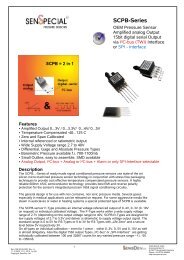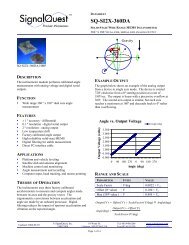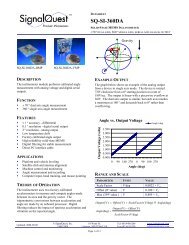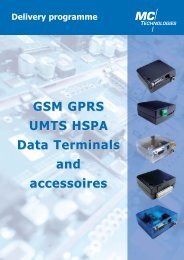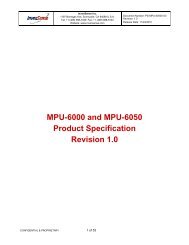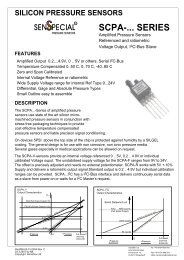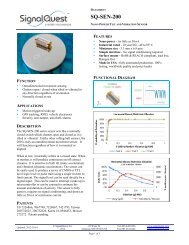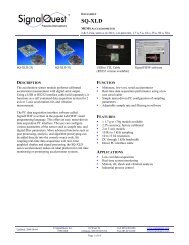ITG-3050 Product Specification Revision 1.3 - InvenSense
ITG-3050 Product Specification Revision 1.3 - InvenSense
ITG-3050 Product Specification Revision 1.3 - InvenSense
Create successful ePaper yourself
Turn your PDF publications into a flip-book with our unique Google optimized e-Paper software.
<strong>ITG</strong>-<strong>3050</strong> <strong>Product</strong> <strong>Specification</strong><br />
Document Number: PS-<strong>ITG</strong>-<strong>3050</strong>-00<br />
<strong>Revision</strong>: <strong>1.3</strong><br />
Release Date: 08/25/2011<br />
<br />
<br />
An internal relaxation oscillator<br />
Any of the X, Y, or Z gyros (MEMS oscillators with a drift of only ±1% over temperature)<br />
Allowable external clocking sources are:<br />
32.768kHz square wave<br />
19.2MHz square wave<br />
Which source to select for generating the internal synchronous clock depends on the availability of external<br />
sources and the requirements for power consumption and clock accuracy. Most likely, these requirements<br />
will vary by mode of operation. For example, in a mode where the gyros are active, selecting the gyros as<br />
the clock source provides for a more-accurate clock source.<br />
There are also start-up conditions to consider. When the <strong>ITG</strong>-<strong>3050</strong> first starts up, the device operates off of<br />
its internal clock, until programmed to operate from another source. This allows the user, for example, to<br />
wait for the MEMS oscillators to stabilize before they are selected as the clock source.<br />
5.8 Clock Output<br />
In addition, the <strong>ITG</strong>-<strong>3050</strong> provides a clock output, which allows the device to operate synchronously with an<br />
external digital 3-axis accelerometer. Operating synchronously provides for higher-quality data, since the<br />
sampling instant for the sensor data can be set to be coincident for all sensors.<br />
5.9 Sensor Data Registers<br />
The sensor data registers contain the latest gyro and temperature data. They are read-only registers, and<br />
are accessed via the Serial Interface. Data from these registers may be read anytime, however, the interrupt<br />
function may be used to determine when new data is available.<br />
5.10 FIFO<br />
The <strong>ITG</strong>-<strong>3050</strong> contains a 512-byte FIFO register that is accessible via the Serial Interface. The FIFO<br />
configuration register determines what data goes into it, with possible choices being gyro data,<br />
accelerometer data, temperature readings, and FSYNC input. A FIFO counter keeps track of how many<br />
bytes of valid data are contained in the FIFO. The FIFO register supports burst reads. The interrupt function<br />
may be used to determine when new data is available.<br />
5.11 Interrupts<br />
Interrupt functionality is configured via the Interrupt Configuration register. Items that are configurable include<br />
the INT pin configuration, the interrupt latching and clearing method, and triggers for the interrupt. Items that<br />
can trigger an interrupt are (1) Clock generator locked to new reference oscillator (used when switching clock<br />
sources); (2) new data is available to be read (from the FIFO and Data registers); and (3) the <strong>ITG</strong>-<strong>3050</strong> did<br />
not receive an acknowledge from the accelerometer on the Secondary I 2 C bus. The interrupt status can be<br />
read from the Interrupt Status register.<br />
5.12 Digital-Output Temperature Sensor<br />
An on-chip temperature sensor and ADC are used to measure the <strong>ITG</strong>-<strong>3050</strong> die temperature. The readings<br />
from the ADC can be read from the FIFO or the Sensor Data registers.<br />
5.13 Bias and LDO<br />
The bias and LDO section generates the internal supply and the reference voltages and currents required by<br />
the <strong>ITG</strong>-<strong>3050</strong>. Its two inputs are an unregulated VDD of 2.1V to 3.6V and a VLOGIC logic reference supply<br />
voltage of 1.71V to VDD. The LDO output is bypassed by a 0.1µF capacitor at REGOUT.<br />
5.14 Charge Pump<br />
An on-board charge pump generates the high voltage required for the MEMS oscillators. Its output is<br />
bypassed by a 2.2nF capacitor at CPOUT.<br />
23 of 42



